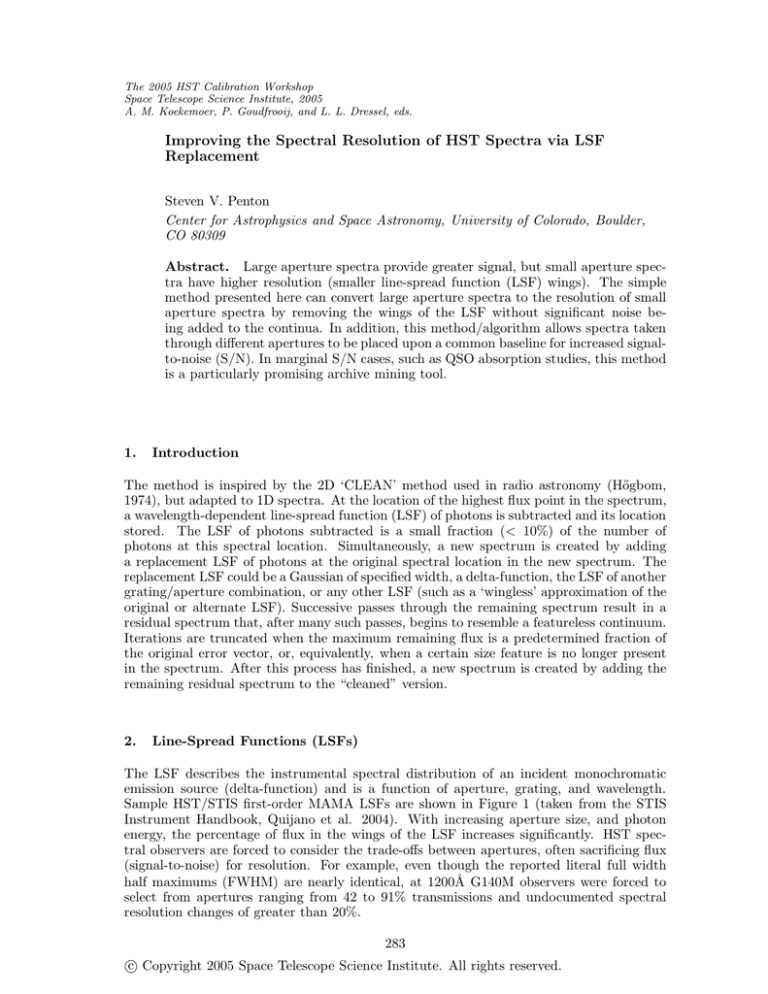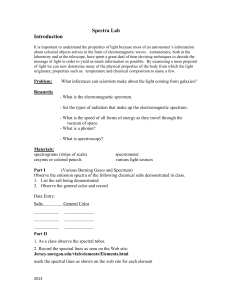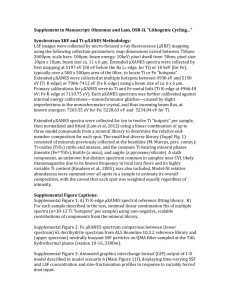
The 2005 HST Calibration Workshop
Space Telescope Science Institute, 2005
A. M. Koekemoer, P. Goudfrooij, and L. L. Dressel, eds.
Improving the Spectral Resolution of HST Spectra via LSF
Replacement
Steven V. Penton
Center for Astrophysics and Space Astronomy, University of Colorado, Boulder,
CO 80309
Abstract. Large aperture spectra provide greater signal, but small aperture spectra have higher resolution (smaller line-spread function (LSF) wings). The simple
method presented here can convert large aperture spectra to the resolution of small
aperture spectra by removing the wings of the LSF without significant noise being added to the continua. In addition, this method/algorithm allows spectra taken
through different apertures to be placed upon a common baseline for increased signalto-noise (S/N). In marginal S/N cases, such as QSO absorption studies, this method
is a particularly promising archive mining tool.
1.
Introduction
The method is inspired by the 2D ‘CLEAN’ method used in radio astronomy (Hőgbom,
1974), but adapted to 1D spectra. At the location of the highest flux point in the spectrum,
a wavelength-dependent line-spread function (LSF) of photons is subtracted and its location
stored. The LSF of photons subtracted is a small fraction (< 10%) of the number of
photons at this spectral location. Simultaneously, a new spectrum is created by adding
a replacement LSF of photons at the original spectral location in the new spectrum. The
replacement LSF could be a Gaussian of specified width, a delta-function, the LSF of another
grating/aperture combination, or any other LSF (such as a ‘wingless’ approximation of the
original or alternate LSF). Successive passes through the remaining spectrum result in a
residual spectrum that, after many such passes, begins to resemble a featureless continuum.
Iterations are truncated when the maximum remaining flux is a predetermined fraction of
the original error vector, or, equivalently, when a certain size feature is no longer present
in the spectrum. After this process has finished, a new spectrum is created by adding the
remaining residual spectrum to the “cleaned” version.
2.
Line-Spread Functions (LSFs)
The LSF describes the instrumental spectral distribution of an incident monochromatic
emission source (delta-function) and is a function of aperture, grating, and wavelength.
Sample HST/STIS first-order MAMA LSFs are shown in Figure 1 (taken from the STIS
Instrument Handbook, Quijano et al. 2004). With increasing aperture size, and photon
energy, the percentage of flux in the wings of the LSF increases significantly. HST spectral observers are forced to consider the trade-offs between apertures, often sacrificing flux
(signal-to-noise) for resolution. For example, even though the reported literal full width
half maximums (FWHM) are nearly identical, at 1200Å G140M observers were forced to
select from apertures ranging from 42 to 91% transmissions and undocumented spectral
resolution changes of greater than 20%.
283
c Copyright 2005 Space Telescope Science Institute. All rights reserved.
284
Penton
Figure 1: STIS first-order MAMA LSFs for the G140L and G140M (top) and G230L and
G230M (bottom). The legend in the upper left gives the aperture, SLIT ID, the percentage
of the incident flux transmitted by the aperture, T(%), and the FWHM of the central core in
pixels, W(px). The wavelength is indicated in the upper right corner. The spectral method
presented here is designed to increase spectral resolution by removing the significant, broad
non-Gaussian wings.
3.
Resolution Enhancement
Spectral resolution (R=λ/∆λ) is often defined by the literal FWHM of the central Gaussian core of a LSF and is only achievable for delta-function absorption or emission lines. To
quantify the achievable resolution for a realistic astrophysical situation, we performed simulations with identical b=20 km/s (Doppler width, Penton et al. 2000) absorption features
of variable separation at 1200Å. We define the resolution R80 as the wavelength divided by
the separation between identical Gaussian absorption features at which the central maxima
between the two minima has a flux deficit of 80% of the feature minima. Sample simulations
for two separations are shown in Figure 2.
We find the resolution (R80) of STIS+G140M at 1200Å to be R80≈5800 (∆λ=0.21Å)
for the 52 × 0.100 aperture and R80≈4500 (∆λ=0.27Å) for 52 × 0.200 . The ‘wingless’ 52 ×
0.100 replacement can resolve features at R80≈6500 (∆λ=0.18Å), and the delta-function
replacement can resolve features at R80≈7700 (∆λ=0.16Å) (see Figure 3). This implies
that we are able to increase STIS/G140M/52×0.200 archive spectra from R80≈4500 to 7700;
a 71% improvement for our delta-function replacement, and a 46% improvement using the
HST Spectral CLEANing
285
Figure 2: Left: A simulated S/N=20 per pixel STIS/G140M spectrum (rectangular contours) with b=20 km/s absorption features separated by 0.25Å (∆V∼60 km/s) is convolved
with the LSF of the 52 × 0.200 aperture (minima ∼170), then cleaned by two different methods (delta function: minima ∼40, wingless 52x0.1: minima ∼100). Shown for comparison is
the convolution of the input spectrum with the 52 × 0.100 LSF (dashed line). Both cleanings
of the input 52 × 0.200 spectra achieve improved resolution and are much better estimates
of the known input spectrum. By our R80 definition, the input+52 × 0.200 simulation does
not resolve the features while the input+52x0.100 and the cleaned spectra do. Right: For
simulated/deconvolved spectral features separated by 0.2Å (∆V∼50 km/s), neither of the
original LSFs resolve the features, yet both spectral cleanings resolve the features.
Figure 3: Simulation statistics (see Figure 2) allow us to calculate the relative resolutions
of the G140M 52 × 0.100 and 52 × 0.200 apertures (upper solid and dashed lines) compared to
spectral cleanings performed on simulated STIS/G140M/52 × 0.200 data (lower solid lines).
Our delta-function and ‘wingless’ 52×0.100 “cleanings” of input+52×0.200 simulations achieve
∼70% and ∼50% higher spectral resolution than the input+52 × 0.200 and input+52 × 0.100
simulations, respectively.
286
Penton
Figure 4: The left panel of the left figure shows the incident (black or dark) and deltafunction-cleaned (red or light) continuum values for a simulated G140M 200 Å continuum
region (52 × 0.200 aperture) with S/N per pixel of 20. The right panel of the left figure shows
the pixel-to-pixel variations (residuals, black bar graph) between the input and cleaned continuum values. A Gaussian fit of the residuals (blue curve) demonstrates that the residuals
appear mainly Gaussian with a σ of ±1.3 counts or 0.3% (1.3/400). The right figure is
identical, except that the S/N=10 per pixel, and the σ is ± 0.7 counts or 0.7% (0.7/100).
In both examples, non-Gaussian excess residuals occur in < 4% of the cleaned continuum,
and the excess is a small fraction of the intrinsic photon noise.
‘wingless’ 52 × 0.100 replacement. We find similar results for low-resolution STIS spectra,
but less dramatic results for echelle data, where the wings of the LSF are less pronounced.
4.
Marginal (1%) Increase in Continuum Noise
To examine the effects of our spectral cleaning on continuum noise, we “cleaned” a simulated
S/N of 20 (per pixel) STIS/G140M spectrum (52 × 0.200 aperture) over a continuum of
200Å (4000 pixels, ∼2600 resolution elements). The input spectrum, containing photon
noise only, was convolved with the 52 × 0.200 aperture LSF, then “cleaned” using a deltafunction replacement. Figure 4 displays a histogram of the before and after continuum
counts (left) and the differences (residuals, right) for a S/N of 20 simulated spectrum. We
are able to retrieve the input spectrum with a 1-σ error of ± 1.3 counts, or 1.3/400 = 0.3%.
For a S/N of 10 spectrum (right panel), we are able to retrieve the continuum to within
0.7%. In both examples, the non-Gaussian component of the residuals is < 4% and is a small
fraction (20%) of the intrinsic photon noise. Further optimization of our algorithm will only
reduce this non-Gaussian noise component. The main point is that even using the most
extreme output LSF, a delta-function, the added non-Gaussian noise is quite small. This
is, of course, a major concern since these non-Gaussian residuals could be misinterpreted
as larger σ deviations and misidentified as real absorption or emission features.
HST Spectral CLEANing
287
Figure 5: An HST/FOS spectrum of PG 0946+301 (G270H, central solid line) and a pipeline
reduction of a similar resolution (G230L STIS, dashed line). Narrow absorption features
Lyα at 2293Å and 2383Å are poorly reproduced by the normal STIS pipeline data reduction.
Our spectral cleaning algorithm recovers the full extent of the absorption lines. The upper
offset (red, top) spectrum is our ‘wingless’ 52 × 0.100 LSF replacement, while the lower offset
(blue, bottom) spectrum is our delta-function replacement. The dot-dashed line shows the
FOS/G270H spectrum degraded to the STIS/G230L resolution.
5.
HST Example
To demonstrate the operation of this algorithm we compare two spectral cleanings of
HST/STIS/G230L/52 × 0.200 observations of the QSO PG 0946+301 (z = 1.216) to the
original spectrum and an HST/FOS/G270H spectrum (Figure 5). The two cleaned spectra
(the ‘wingless’ 52 × 0.100 and delta-function replacements) show deeper absorption features,
more like the HST/FOS/G270H spectrum. In particular, narrow absorption features, such
as Lyα at 2293Å and 2383Å, are poorly reproduced by the normal STIS pipeline data reduction, but are recovered by our spectral cleaning, which looks very similar to the FOS/G270H
spectrum degraded to the STIS/G230L resolution.
6.
Combining Spectra
At some level, all HST archival spectra should benefit from our spectral cleaning. However,
of the 20,400 first-order STIS spectra in the archive, the ∼15,600 (76%) that were taken
with larger (> 0.100 ) apertures will benefit the most from our spectral cleaning due to the
significant LSF wings. Once “cleaned, these larger aperture datasets can be combined with
other “cleaned” observations of the same target taken through other apertures without
spectral degradation to produce higher signal-to-noise. In other words, this method allows
archive users to place observations taken through different apertures onto a common frame.
In addition, the negative impact of non-Gaussian wings of the LSF can be removed, resulting
288
Penton
in increased resolution with minimal contribution to continuum noise. Our algorithm works
for all HST modes for which the LSF is well known.
7.
Conclusions
By removing the non-Gaussian wings of the LSF, our algorithm increases the resolution of
HST archive spectra by as much as 70% for the STIS medium resolution gratings, while
introducing < 1% noise to the continuum. Our algorithm also allows spectra taken through
different apertures to be combined in a way that actually increases the S/N and spectral
resolution.
7.1.
Caveats
• The algorithm only works if the LSF is well-known.
• This algorithm is ONLY designed to correct non-Gaussian LSF wings. If the intrinsic
LSF does contain significant wings (i.e., HST/STIS echelle data), then this algorithm
will not significantly improve the data, except in the case of combining data taken
with different apertures.
• The algorithm is still under development and has not yet been applied to more than
a couple of HST archive datasets. So, for now, one must consider this a promising,
but unproven, calibration tool.
• There are several subtle nuances of the algorithm (which do not affect the statistics)
that are not revealed here due to space limitations.
• Objects not centered in the aperture may have distorted LSFs, which cannot be corrected. This will result in decreased resolution improvement and increased continuum
noise.
References
Hőgbom, J. A. 1974, A&AS, 15, 417
Kim Quijano, J., et al. 2004, STIS Instrument Handbook (Baltimore: STScI)
Penton, S. V., Stocke, J. T., & Shull, J. M. 2000, ApJS, 130, 121








